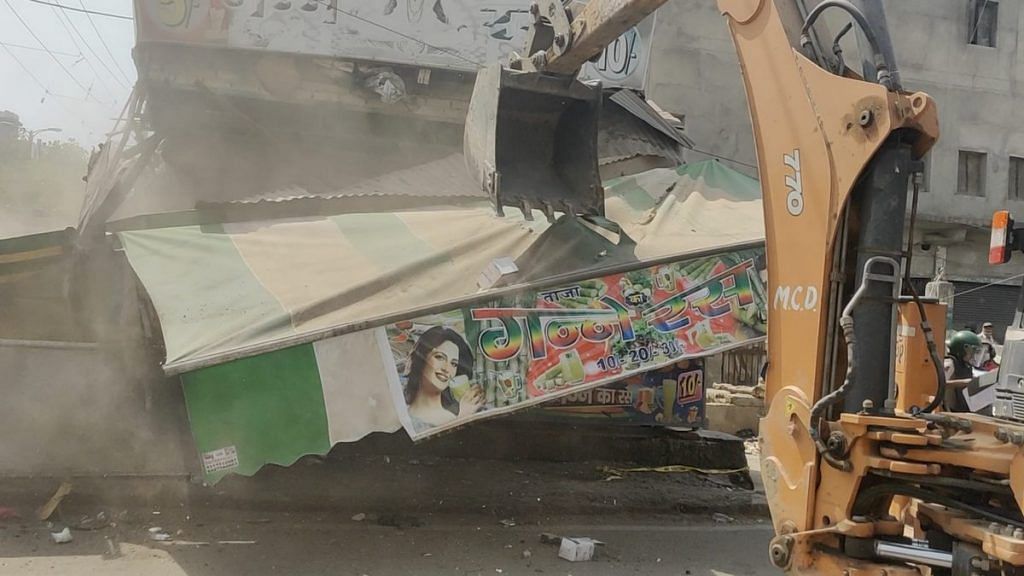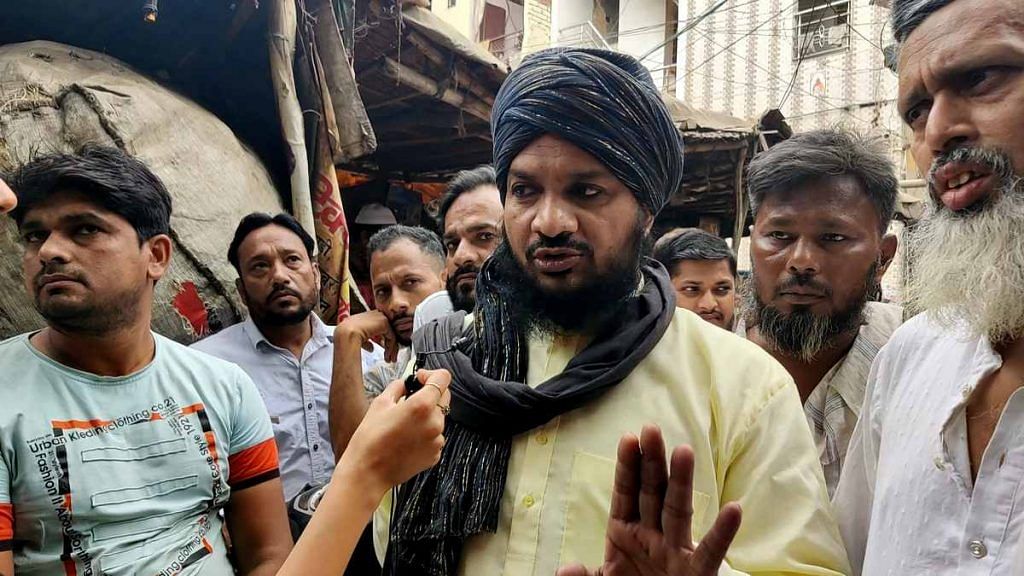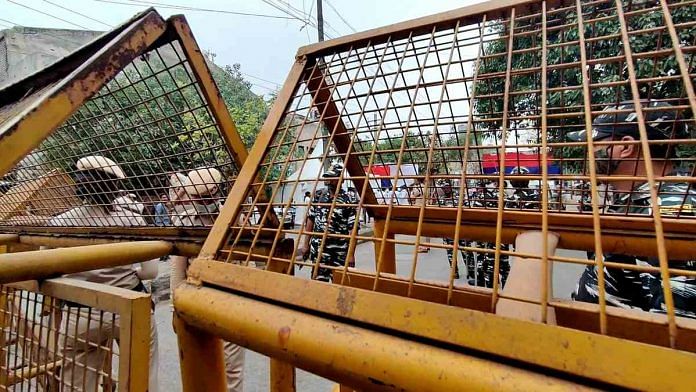New Delhi: “I have lived here with all other communities for more than four decades. Nothing ever happened in the past. Then why now?” asks Jahangirpuri resident Tarun Kumar. “Someone must have provoked the crowd this time, right?”
Kumar, who runs a small water shop about 20 metres from Kushal Chowk, has laid out chairs so that he and fellow shopkeepers — Hindus as well as Muslims — can keep an eye on the hubbub around them.
There’s still a sense that anything might happen at any moment at this location, where communal clashes and then a demolition drive turned life upside down since last Saturday.
The footfall at Kumar’s shop is heavy Thursday, the day after the demolition drive. Every few minutes, a policeman walks up to Kumar with an empty water bottle to be refilled with a tube attached to a big tank.
There are still barricades on all sides of the square and hundreds of Delhi Police, CRPF, and Rapid Action Force personnel dominate the streets. Throngs of mediapersons and some politicians also keep them company. Huge tents with carpets and fans have been erected in the middle of the roads.
‘Aisi rally kabhi nahi dekhi’
Kumar and others in the northwest Delhi neighbourhood, dominated by lower income groups, are still reeling from the events of last Saturday, when Hanuman Jayanti processions morphed into a riot where people openly brandished knives and swords at each other.
Three rallies of about 200 people each were taken out, allegedly by three different informal groups, on the road where a temple and mosque stand barely 20 steps away from each other.
“Aisi rally kabhi nahi dekhi (I have never seen such a rally),” Sharjul Shah, a tea seller, says. His shop has been shut ever since the clashes, and he is waiting till normalcy resumes to start business again.
Perched on a chair outside Kumar’s shop, Shah recalls the events of the night. The people in the procession were singing a song, he says. “It went ‘Jo Hindustan mein rahega wo Siya Ram kahega (Whoever lives in India has to say Siya-Ram).”
It looked as if the boys in the rally “had come prepared for a fight”, he adds.
The neighbourhood went through even more turmoil three days later when the North Delhi Municipal Corporation drove bulldozers along the same stretch of road and razed “illegal encroachments” — shops and other temporary structures — which people were using to do small businesses. The external gate of the mosque that was at the centre of Saturday’s controversy was also demolished.

The demolitions have stopped now, in the wake of a ‘status quo’ order from the Supreme Court, but residents are still shaken up.
Warnings about an impending demolition are not new in Jahangirpuri, but this time, the residents believe that it is a consequence not of building illegal structures, but of the clashes that took place Saturday night.
A day before the anti-encroachment drive by the North Delhi Municipal Corporation, Delhi BJP chief Adesh Gupta had asked the North Delhi Mayor Raja Iqbal Singh, who belongs to the same party, to identify the “illegal encroachments” of those arrested after the clashes.
However, locals claim that the bulldozers razed properties that belonged even to those who were not arrested in connection with the clashes. Muslims as well as Hindus were affected.
Also Read: A spat, a human chain formed by cops, sloganeering & a flare-up — what happened in Jahangirpuri
Some finger-pointing at ‘Bengali colony’
The working-class township of Jahangirpuri has grown exponentially in the last few years. It is located close to Asia’s largest vegetable and fruit market — Azadpur — and connected to the Delhi Metro as well as by road to the industrial towns of Sonipat and Panipat in Haryana.
Less felicitous, however, is its proximity to the Bhalswa landfill. A settlement of ragpickers and waste segregators has cropped up here. The locals refer to it as the “Bengali colony” and claim that it is inhabited primarily by Muslim refugees and migrants from Myanmar and Bangladesh).
It is this community, many residents living nearby told ThePrint, that is the “troublemaker”, and that using force to remove them is justified.
“They cut meat openly and their lanes are so filthy. Women cannot even walk safely there. What is wrong with the demolition drive? Their large garbage bags block the roads,” Ramesh Kumar, who lives in the next block, says.
A few houses away, Sarvesh, sitting with two other women from the neighbourhood, echoes this sentiment.
“They are thieves. They take away the metal grilles of the parks,” she says. When asked, she says she has never witnessed anyone from colony actually stealing.
Some residents, like Ramesh Kumar, are now alleging that glass bottles and rocks collected from the garbage were thrown at the Hanuman Jayanti rally.
Such accusations outrage the people living in the lanes of Bengali Colony.

“When there is a Dharam Sansad in the country every other day, where there is an open call to arms against the Muslims to provoke the people, it is they who then come prepared to these rallies,” Mohammed Raees Khan Anoori, who runs a kajal and ittar shop, says.
According to him, the demolitions in this sensitive area could have happened later, but have instead made a bad situation worse.
Waiting for the dust to settle
The inside lanes of Jahangirpuri are eerily calm. People go about their business, occasionally peeping through the large metal gates which are kept locked and heavily guarded by security forces. They are curious to know which political leader is visiting next.
Men from investigating agencies in crisp white shirts and stony faces stand at street corners, copying footage from CCTV cameras to their laptops.
As the day progresses, the security personnel on the ground show no sign of dispersing. A few men wear riot gear and boxes of tear gas are stacked at various points.
On the lane where the mosque and temple stand together, big yellow and blue plastic sheets roughly cover the broken bricks, tiles, tin roofs, and wooden frames which the bulldozers left behind.
For many people, rebuilding from these ravages is a daunting prospect. They aren’t sure how much they can salvage.
And in the busy lanes of Jahangirpuri, one question which auto driver Ganga Ram feels will never be answered is: “Which side did the first stone come from?”
(Edited by Asavari Singh)
Also Read: ‘No one listened’: Jahangirpuri residents cry after bulldozers raze ‘illegal’ shops & structures



